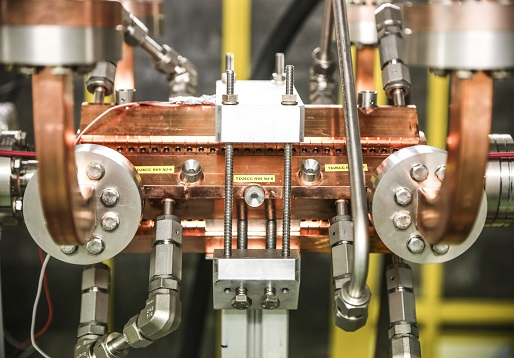The Cockcroft Institute is helping to apply advanced linac technology developed at CERN to design a new generation of compact X-ray free-electron lasers (XFELs), thanks to a €3 million project funded by the European Commission’s Horizon 2020 programme. Beginning in January 2018, “CompactLight” aims to design the first hard XFEL based on 12 GHz X-band technology, which originated from research for a high-energy linear collider. A consortium of 24 partners, including STFC Daresbury Laboratory , Strathclyde University, Lancaster University, and CERN are collaborating to achieve this ambitious goal within the three-year duration of the recently awarded grant.

CLIC TD24CC structure installed at the X-band high gradient test facility at CERN. Image Credit: Matteo Volpi
X-band technology, which provides accelerating-gradients of 100 MV/m and above in a highly compact device, is now a reality. This is the result of many years of intense R&D carried out at SLAC (US) and KEK (Japan), for the former NLC and JLC projects, and at CERN in the context of the Compact Linear Collider (CLIC). This pioneering technology also withstood validation at the Elettra and PSI laboratories and will soon be applied to our own CLARA project.
Staff at Lancaster and Strathclyde will be contributing to the advanced RF systems required by this state-of-the-art project whilst staff in ASTeC will be coordinating the full facility design and specification and making contributions to specific aspects of the project, such as the undulators and FEL layout.
XFELs, the latest generation of light sources, are particularly suitable applications for high-gradient X-band technology. Following decades of growth in the use of synchrotron X-ray facilities to study materials across a wide spectrum of sciences, technologies and applications, XFELs are now capable of delivering the brightest X-ray beams on Earth. This provides novel ways to probe matter and allows researchers to make “movies” of ultrafast biological processes.
The first XFEL uses conventional 3 GHz S-band technology ( LCLS in the US), more recent ones use superconducting 1.3 GHz structures (e.g. European XFEL), or are based on 6 GHz C-band technology (e.g. SCALA in Japan and SwissFEL in Switzerland), which increases the accelerating gradient while reducing the linacs length and cost. CompactLight gathers leading experts to design a hard-X-ray facility beyond today’s state of the art, using the latest concepts for bright electron-photo injectors, very-high-gradient X-band structures operating at frequencies of 12 GHz, and innovative compact short-period undulators. Compared with existing XFELs, the proposed facility will benefit from a lower electron-beam energy (due to the enhanced undulator performance), be significantly more compact (as a consequence both of the lower energy and of the high-gradient X-band structures), have lower electrical power demand and a smaller footprint.
Success for CompactLight will have a much wider impact: not just affirming X-band technology as a new standard for accelerator-based facilities, but advancing undulators to the next generation of compact photon sources. This will facilitate the widespread distribution of a new generation of compact X-band-based accelerators and light sources, with a large range of applications including medical use, and enable the development of compact cost-effective X-ray facilities at national or even university level across and beyond Europe.
